
Back to Basics: April 2013
Mark Van
Features Fire Ground TrainingBack in the January 2012 issue of Canadian Firefighter and EMS Quarterly, we looked at using enlarged openings to expedite the removal of the mayday firefighter from a structure.
Back in the January 2012 issue of Canadian Firefighter and EMS Quarterly, we looked at using enlarged openings to expedite the removal of the mayday firefighter from a structure. That column considered how this technique could be used for both interior and exterior applications. Safety was stressed, as it is necessary to have a co-ordinated effort on both sides of the wall to ensure that no other firefighters, including the RIT firefighters, are injured by the tools being used.
That column addressed the removal of a mayday firefighter from the ground floor of a structure. When the mayday firefighter is on the second storey of a structure, removal through an enlarged opening may be the best option, depending on a few important factors:
- Distance to the primary entrance or exit:
– It may be quicker and easier to make a new exit point.
– Consider the time taken to reach the mayday firefighter – the route may be long and arduous.
- Nature of injuries to the mayday firefighter:
– Injuries sustained may be aggravated during removal through a door, down a set of stairs and/or going around corners.
- Air supply status for RIT and mayday firefighters:
– Air supply may be running low for all involved and overall supply may be limited.
- Manpower needed to remove the mayday firefighter:
– There may be limited resources on hand to move the mayday firefighter to a primary exit point. This removal may involve a rotation of teams.
Creating an elevated enlarged opening can be a tricky operation if it is not practised. These skills should be perfected on the training ground. This operation requires a team on the outside and a team on the inside; right away, staffing becomes an issue. The inside team should include a safety officer and a RIT firefighter to remediate and prep the inside of the window. Usually, a window is the best option for an exit but patio doors leading to an elevated deck over a garage, for example, are sometimes available.
The outside team should include at least two RIT firefighters to work the ladder and enlarge the window, and a safety officer. The outside operation requires the following tools:
- maul or sledge
- flathead axe
- pike pole or roof hoof
- vent saw or chainsaw
- ladders (2)
- portable radio
The inside team needs:
- Halligan
- flathead or pickhead axe
- thermal imaging camera
- portable radio
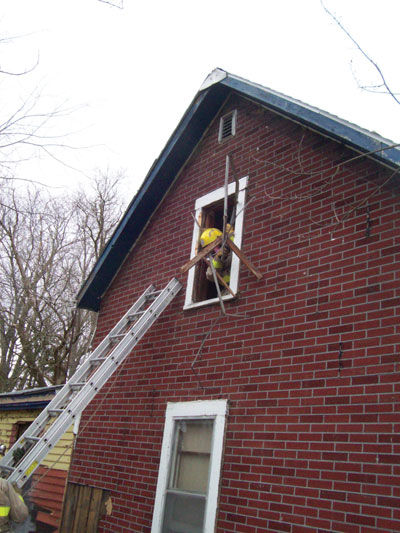 |
|
| Photo 1: A RIT firefighter clears out the glass and wall material, making way for the removal of the exterior wall. |
|
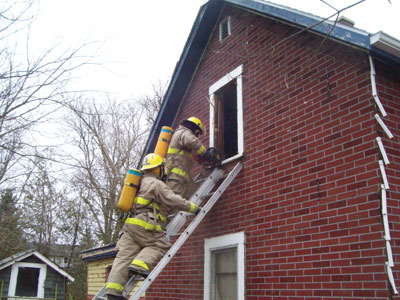 |
|
| Photo 2: One RIT firefighter supports and guides a second firefighter, who is cutting the exterior wall of a structure. |
|
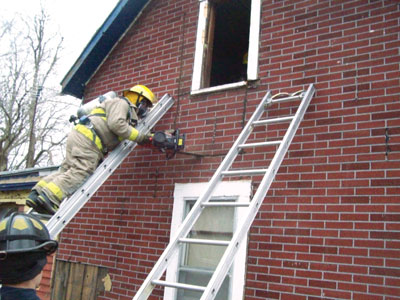 |
|
| Photo 3: The final cuts are completed by a RIT firefighter, and the enlarged opening is beginning to take shape. |
|
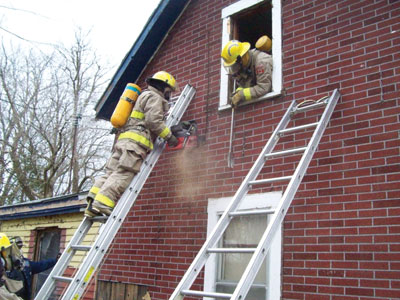 |
|
| Photo 4: A RIT member on the inside of the structure uses a Halligan as a guide for the RIT member on the outside of a structure. Using a Halligan or an axe as a measuring gauge helps the efficiency of the operation. |
|
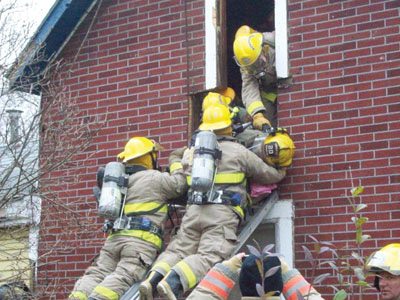 |
|
| Photo 5: The RIT members on the inside and on the outside co-ordinate the removal of a mayday firefighter on the second floor of a structure.
|
The inside team will strip away all the molding around the window, remove any obstructions around or below the window, clear a path for the removal of the mayday firefighter and, depending on the thickness of the wall, clear out the glass (see photo 1) and start to remove the wall material where the opening will be made. The thickness of the wall will have an impact on the chain depth of the vent or chain saw. The chain may not be long enough to cut through the wall completely. Removing the interior wall surface allows the saw to cut through completely.
The outside team, using one or two ground ladders to reach the window, starts to make cuts around the window. As shown in photo 2, one RIT firefighter is being supported and guided by the other RIT firefighter as the cut is being made. Notice that the cut is started in the corner of the window, moving away from it. This can be done on either side of the wall; the process will be dictated by the team members on the inside of the structure. When using the vent saw or chainsaw, remember to operate it at full throttle to optimize performance.
In photo 3, you can see one RIT firefighter completing the bottom cut. You can see the cut lines of the opening taking shape. This is where two RIT firefighters can work together on two separate ladders: one can be on one side of the window and one on the other side. They can pass the saw to each other to expedite the cutting process. While one cut is being made, the other RIT firefighter can use a pike pole to hold the cut section in place; this prevents it from falling and injuring someone. This can be done from on the ladder, just off to the side, or on the ground, if the pike pole is long enough.
In photo 4, the inside team member is letting the outside team member know how far down to cut. The inside RIT firefighter is showing the distance of the cut to be made by using the Halligan as a measuring gauge. Once the cuts have been completed, the cut section needs to be removed. The best place for the debris is on the outside of the structure. Make sure there is no one standing below the area when pulling or pushing the cut section out and away.
Photo 5 shows the finished product and the commencement of the removal of the mayday firefighter. Two RIT firefighters side by side will help to control the movement of the RIT firefighter down the ladder. Depending on the size and height of the mayday firefighter, a third ladder and RIT firefighter can be used.
This operation will take practice to be effective on the fire ground. Acquired structures are great for this as they are generally two storeys with numerous windows on the second floor.
Mark van der Feyst is a 14-year veteran of the fire service. He works for the City of Woodstock Fire Department in Ontario. Mark instructs in Canada, the United Stats and India and is a local-level suppression instructor for the Pennsylvania State Fire Academy and an instructor for the Justice Institute of B.C. E-mail Mark at Mark@FireStarTraining.com
Print this page